Evaluation of the Seasonal Thermal Environmental Benefits of Urban Green Space in the Core Areas of Urban Heat Island
Abstract
1. Introduction
2. Data and Methodology
2.1. Study Area
2.2. Datasets
2.3. Methodology
2.3.1. LST Retrieval
2.3.2. The Identification of CAUHI
2.3.3. UGS Metrics
2.3.4. The Green Environmental Benefit Index Model
3. Results
3.1. Seasonal Distribution of the CAUHI in Study Area
3.2. Pearson Correlation Analysis between UGS Metrics and Seasonal LST
3.3. Analysis of UGS Metrics Influencing Seasonal LST based on Geodetector
3.4. Thermal Environmental Benefits Evaluation of UGS
4. Discussion
4.1. Influence of the UGS Metrics on Seasonal LST
4.2. Evaluation of the Thermal Environmental Benefits of the Model
4.3. Limitations
5. Conclusions
Author Contributions
Funding
Data Availability Statement
Conflicts of Interest
References
- Manley, G. On the frequency of snowfall in metropolitan England. Q. J. R. Meteorol. Soc. 1958, 84, 70–72. [Google Scholar] [CrossRef]
- Oke, T.R. The energetic basis of the urban heat island. Q. J. R. Meteorol. Soc. 1982, 108, 1–24. [Google Scholar] [CrossRef]
- Schwarz, N.; Schlink, U.; Franck, U.; Groβmann, K. Relationship of land surface and air temperatures and its implications for quantifying urban heat island indicators—An application for the city of Leipzig (Germany). Ecol. Indicators 2012, 18, 693–704. [Google Scholar] [CrossRef]
- Arnfield, A.J. Two decades of urban climate research: A review of turbulence, exchanges of energy and water, and the urban heat island. Int. J. Climatol. 2003, 23, 1–26. [Google Scholar] [CrossRef]
- Grimm, N.B.; Faeth, S.H.; Golubiewski, N.E.; Redman, C.L.; Wu, J.; Bai, X.; Briggs, J.M. Global Change and the Ecology of Cities. Science 2008, 319, 756–760. [Google Scholar] [CrossRef] [PubMed]
- Tang, Z.H.; Li, Y.; Gu, Y.; Jiang, W.; Xue, Y.; Hu, Q.; Li, R. Assessing Nebraska play a wetland inundation status during 1985-2015 using Landsat data and Google Earth Engine. Environ. Monit. Assess. 2016, 188, 654. [Google Scholar] [CrossRef]
- Liu, J.; Zhang, S.; Yin, L.; Li, B.; Zhang, B. Exploring the relationship between seasonal variations of land surface temperature and urban morphological factors in complex urban areas. Env. Sci. Pollut. Res. Int. 2023, 30, 59861–59876. [Google Scholar] [CrossRef] [PubMed]
- Liu, Y.; Wang, Z.; Liu, X.; Zhang, B. Complexity of the relationship between 2D/3D urban morphology and the land surface temperature: A multiscale perspective. Env. Sci. Pollut. Res. Int. 2021, 28, 66804–66818. [Google Scholar] [CrossRef]
- Zhou, L.; Hu, F.; Wang, B.; Wei, C.; Sun, D.; Wang, S. Relationship between urban landscape structure and land surface temperature: Spatial hierarchy and interaction effects. Sustain. Cities Soc. 2022, 80, 103795. [Google Scholar] [CrossRef]
- Ge, X.; Mauree, D.; Castello, R.; Scartezzini, J.-L. Spatio-Temporal Relationship between Land Cover and Land Surface Temperature in Urban Areas: A Case Study in Geneva and Paris. ISPRS Int. J. Geo-Inf. 2020, 9, 593. [Google Scholar] [CrossRef]
- Chen, S.; Yu, Z.; Liu, M.; Da, L.; Faiz Ul Hassan, M. Trends of the contributions of biophysical (climate) and socioeconomic elements to regional heat islands. Sci. Rep. 2021, 11, 12696. [Google Scholar] [CrossRef]
- Qiao, Z.; Wu, C.; Zhao, D.; Xu, X.; Yang, J.; Feng, L.; Sun, Z.; Liu, L. Determining the Boundary and Probability of Surface Urban Heat Island Footprint Based on a Logistic Model. Remote Sens. 2019, 11, 1368. [Google Scholar] [CrossRef]
- Cui, L.; Wang, J.; Sun, L.; Lv, C. Construction and optimization of green space ecological networks in urban fringe areas: A case study with the urban fringe area of Tongzhou district in Beijing. J. Clean. Prod. 2020, 276, 118360. [Google Scholar] [CrossRef]
- Han, X.; Yu, J.; Shi, L.n.; Zhao, X.; Wang, J. Spatiotemporal evolution of ecosystem service values in an area dominated by vegetation restoration: Quantification and mechanisms. Ecol. Indic. 2021, 131, 108191. [Google Scholar] [CrossRef]
- An, H.; Cai, H.; Xu, X.; Qiao, Z.; Han, D. Impacts of Urban Green Space on Land Surface Temperature from Urban Block Perspectives. Remote Sens. 2022, 14, 4580. [Google Scholar] [CrossRef]
- Tian, Y.; Jim, C.Y.; Wang, H. Assessing the landscape and ecological quality of urban green spaces in a compact city. Landsc. Urban Plan. 2014, 121, 97–108. [Google Scholar] [CrossRef]
- Han, D.; Xu, X.; Qiao, Z.; Wang, F.; Cai, H.; An, H.; Jia, K.; Liu, Y.; Sun, Z.; Wang, S.; et al. The roles of surrounding 2D/3D landscapes in park cooling effect: Analysis from extreme hot and normal weather perspectives. Build. Environ. 2023, 231, 107087. [Google Scholar] [CrossRef]
- Harbin, L.; Jianguo, W. Use and misuse of landscape indices. Landsc. Ecol. 2004, 19, 389–399. [Google Scholar] [CrossRef]
- Jianguo, W.; Darrel, G.; Alexander, J.; Charles, B.; Redman, L. Quantifying spatiotemporal patterns of urbanization: The case of the two fastest growing metropolitan regions in the United States. Ecol. Complex. 2010, 8, 1–8. [Google Scholar] [CrossRef]
- Tian, Y.; Jim, C.Y.; Tao, Y.; Shi, T. Landscape ecological assessment of green space fragmentation in Hong Kong. Urban For. Urban Green. 2011, 10, 79–86. [Google Scholar] [CrossRef]
- Zhong, Z.H.; Weiqi, Z.H.; Jia, W.; Xiaofang, H.; Yuguo, Q. Sixty-Year Changes in Residential Landscapes in Beijing: A Perspective from Both the Horizontal (2D) and Vertical (3D) Dimensions. Remote Sens. 2017, 9, 992. [Google Scholar] [CrossRef]
- Bin, L.; Baolei, Z.; Le, Y.; Jun, C. Assessing heat risk for residents of complex urban areas from an accessibility-based perspective. Sustain. Cities Soc. 2023, 88, 104278. [Google Scholar] [CrossRef]
- Chen, B.; Xie, M.; Feng, Q.; Li, Z.; Chu, L.; Liu, Q. Heat risk of residents in different types of communities from urban heat-exposed areas. Sci. Total Env. 2021, 768, 145052. [Google Scholar] [CrossRef] [PubMed]
- Wang, X.; Meng, Q.; Zhang, L.; Hu, D. Evaluation of urban green space in terms of thermal environmental benefits using geographical detector analysis. Int. J. Appl. Earth Obs. Geoinf. 2021, 105, 102610. [Google Scholar] [CrossRef]
- Wang, F.; Qin, Z.; Song, C.; Tu, L.; Karnieli, A.; Zhao, S. An Improved Mono-Window Algorithm for Land Surface Temperature Retrieval from Landsat 8 Thermal Infrared Sensor Data. Remote Sens. 2015, 7, 4268–4289. [Google Scholar] [CrossRef]
- Xue, L.; Yuyu, Z.H.; Wenze, Y.; Xuecao, L.; Yong, L.; Debin, L. Spatiotemporal patterns of summer urban heat island in Beijing, China using an improved land surface temperature. J. Clean. Prod. 2020, 257, 120529. [Google Scholar] [CrossRef]
- Bureau, B.S. Beijing Statistical Yearbook; China Statistics Press: Beijing, China, 2022.
- Sun, R.; Chen, L. Effects of green space dynamics on urban heat islands: Mitigation and diversification. Ecosyst. Serv. 2017, 23, 38–46. [Google Scholar] [CrossRef]
- Ke, X.; Men, H.; Zhou, T.; Li, Z.; Zhu, F. Variance of the impact of urban green space on the urban heat island effect among different urban functional zones: A case study in Wuhan. Urban For. Urban Green. 2021, 62, 127159. [Google Scholar] [CrossRef]
- Tu, L.; Qin, Z.; Li, W.; Geng, J.; Yang, L.; Zhao, S.; Zhan, W.; Wang, F. Surface urban heat island effect and its relationship with urban expansion in Nanjing, China. J. Appl. Remote Sens. 2016, 10, 26037. [Google Scholar] [CrossRef]
- Peng, J.; Hu, Y.; Dong, J.; Liu, Q.; Liu, Y. Quantifying spatial morphology and connectivity of urban heat islands in a megacity: A radius approach. Sci. Total Env. 2020, 714, 136792. [Google Scholar] [CrossRef]
- Tran, H.; Uchihama, D.; Ochi, S.; Yasuoka, Y. Assessment with satellite data of the urban heat island effects in Asian mega cities. Int. J. Appl. Earth Obs. Geoinf. 2006, 8, 34–48. [Google Scholar] [CrossRef]
- Soille, P.; Vogt, P. Morphological segmentation of binary patterns. Pattern Recognit. Lett. 2009, 30, 456–459. [Google Scholar] [CrossRef]
- Wei, Q.; Halike, A.; Yao, K.; Chen, L.; Balati, M. Construction and optimization of ecological security pattern in Ebinur Lake Basin based on MSPA-MCR models. Ecol. Indic. 2022, 138, 108857. [Google Scholar] [CrossRef]
- Lian, Z.; Feng, X. Urban Green Space Pattern in Core Cities of the Greater Bay Area Based on Morphological Spatial Pattern Analysis. Sustainability 2022, 14, 12365. [Google Scholar] [CrossRef]
- Chen, A.; Yao, X.A.; Sun, R.; Chen, L. Effect of urban green patterns on surface urban cool islands and its seasonal variations. Urban For. Urban Green. 2014, 13, 646–654. [Google Scholar] [CrossRef]
- Yao, L.; Li, T.; Xu, M.; Xu, Y. How the landscape features of urban green space impact seasonal land surface temperatures at a city-block-scale: An urban heat island study in Beijing, China. Urban For. Urban Green. 2020, 52, 126704. [Google Scholar] [CrossRef]
- Li, X.; Zhou, W.; Ouyang, Z.; Xu, W.; Zheng, H. Spatial pattern of greenspace affects land surface temperature: Evidence from the heavily urbanized Beijing metropolitan area, China. Landsc. Ecol. 2012, 27, 887–898. [Google Scholar] [CrossRef]
- Bao, T.; Li, X.; Zhang, J.; Zhang, Y.; Tian, S. Assessing the Distribution of Urban Green Spaces and its Anisotropic Cooling Distance on Urban Heat Island Pattern in Baotou, China. ISPRS Int. J. Geo-Inf. 2016, 5, 12. [Google Scholar] [CrossRef]
- Yuan, B.; Zhou, L.; Dang, X.; Sun, D.; Hu, F.; Mu, H. Separate and combined effects of 3D building features and urban green space on land surface temperature. J. Env. Manag. 2021, 295, 113116. [Google Scholar] [CrossRef]
- Buyantuyev, A.; Wu, J. Urban heat islands and landscape heterogeneity: Linking spatiotemporal variations in surface temperatures to land-cover and socioeconomic patterns. Landsc. Ecol. 2009, 25, 17–33. [Google Scholar] [CrossRef]
- Kong, F.; Yin, H.; James, P.; Hutyra, L.R.; He, H.S. Effects of spatial pattern of greenspace on urban cooling in a large metropolitan area of eastern China. Landsc. Urban Plan. 2014, 128, 35–47. [Google Scholar] [CrossRef]
- Li, X.; Zhou, W.; Ouyang, Z. Relationship between land surface temperature and spatial pattern of greenspace: What are the effects of spatial resolution? Landsc. Urban Plan. 2013, 114, 1–8. [Google Scholar] [CrossRef]
- Zhou, W.; Huang, G.; Cadenasso, M.L. Does spatial configuration matter? Understanding the effects of land cover pattern on land surface temperature in urban landscapes. Landsc. Urban Plan. 2011, 102, 54–63. [Google Scholar] [CrossRef]
- Aubrecht, C.; Ozceylan, D. Identification of heat risk patterns in the U.S. National Capital Region by integrating heat stress and related vulnerability. Env. Int. 2013, 56, 65–77. [Google Scholar] [CrossRef]
- Musse, M.A.; Barona, D.A.; Santana Rodriguez, L.M. Urban environmental quality assessment using remote sensing and census data. Int. J. Appl. Earth Obs. Geoinf. 2018, 71, 95–108. [Google Scholar] [CrossRef]
- Onishi, A.; Cao, X.; Ito, T.; Shi, F.; Imura, H. Evaluating the potential for urban heat-island mitigation by greening parking lots. Urban For. Urban Green. 2010, 9, 323–332. [Google Scholar] [CrossRef]
- Wang, C.; Wang, Z.-H.; Wang, C.; Myint, S.W. Environmental cooling provided by urban trees under extreme heat and cold waves in U.S. cities. Remote Sens. Environ. 2019, 227, 28–43. [Google Scholar] [CrossRef]
- Li, J.; Song, C.; Cao, L.; Zhu, F.; Meng, X.; Wu, J. Impacts of landscape structure on surface urban heat islands: A case study of Shanghai, China. Remote Sens. Environ. 2011, 115, 3249–3263. [Google Scholar] [CrossRef]
- Yu, Z.; Zhang, J.; Yang, G. How to build a heat network to alleviate surface heat island effect? Sustain. Cities Soc. 2021, 74, 103135. [Google Scholar] [CrossRef]

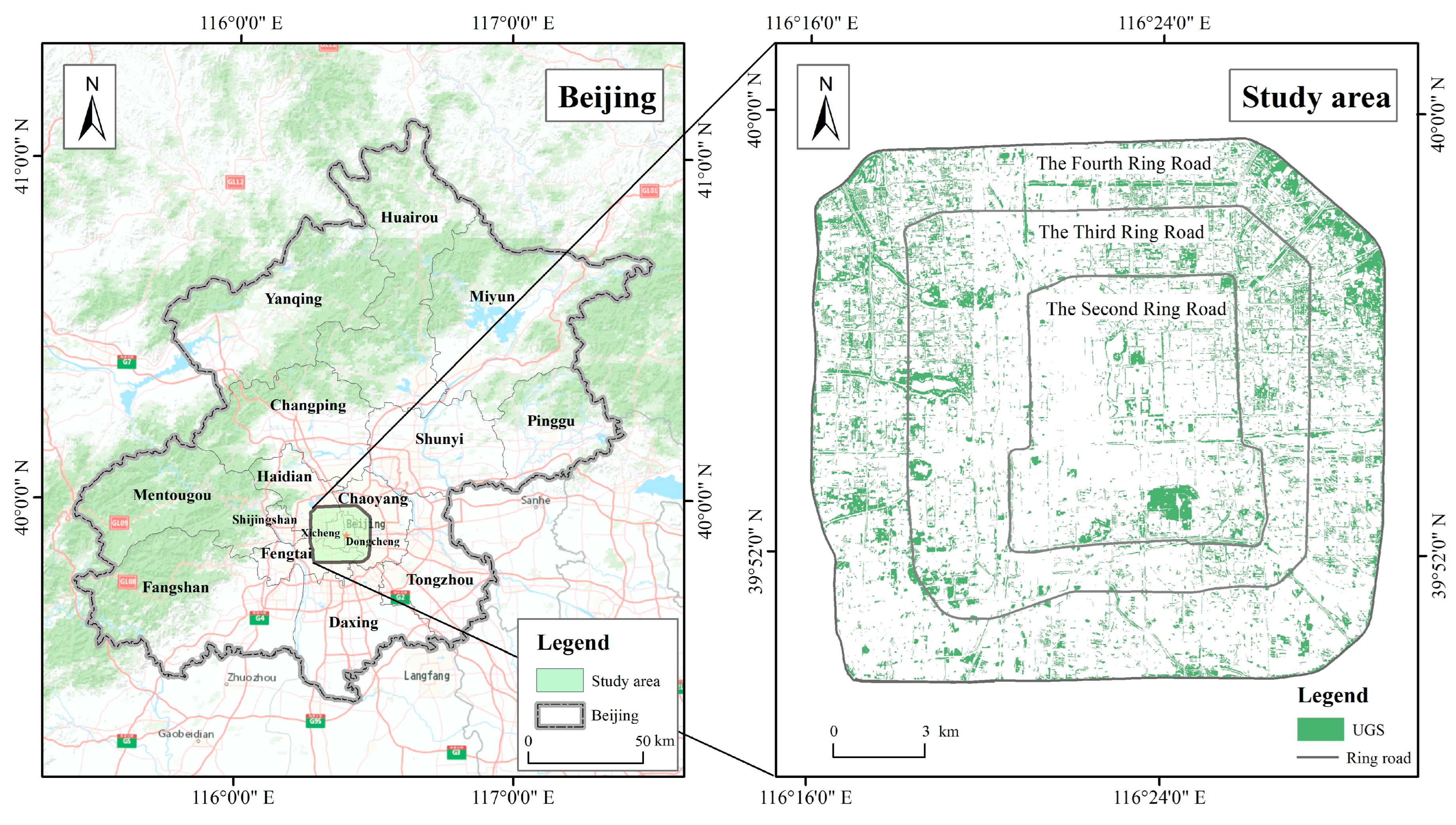
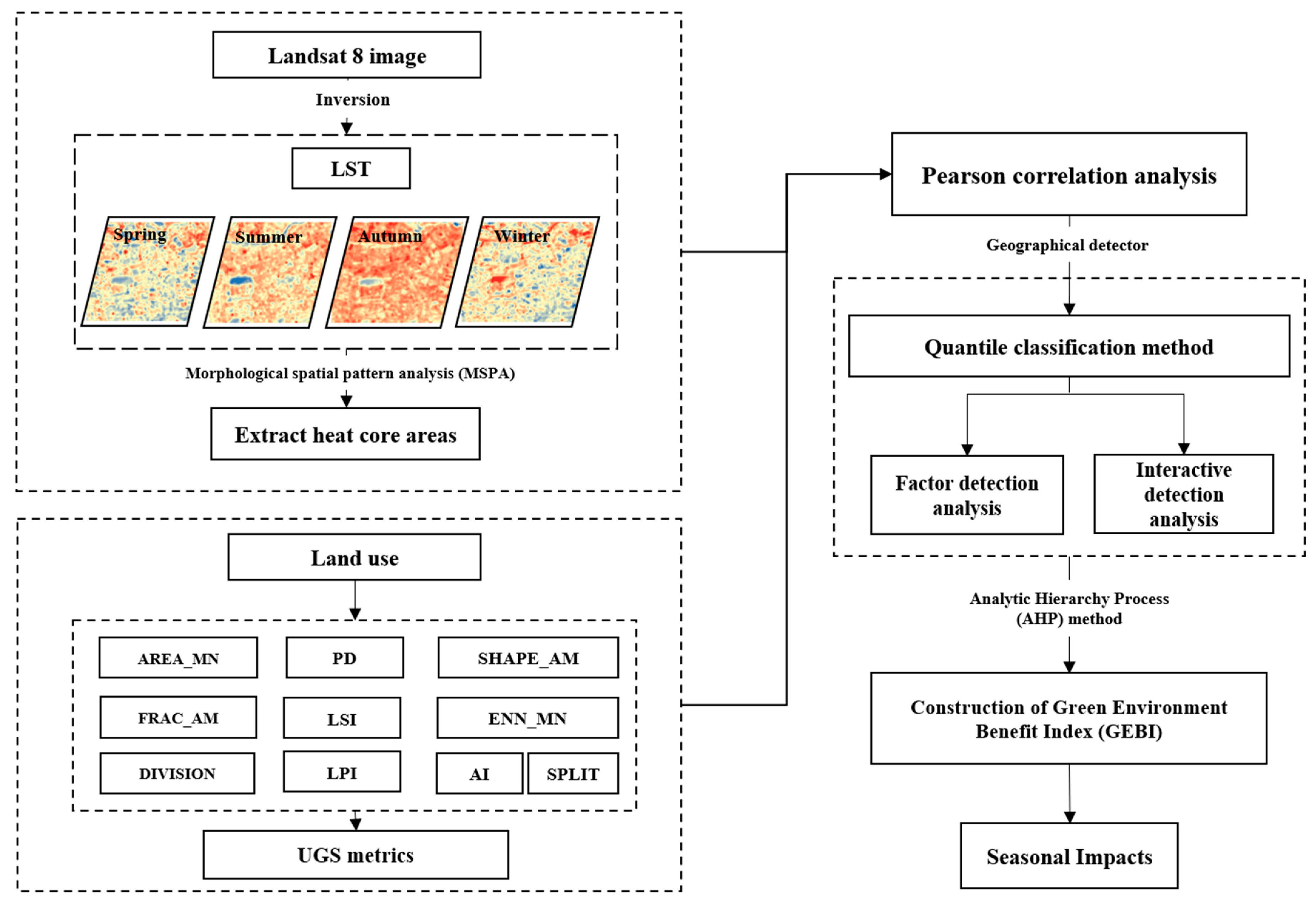
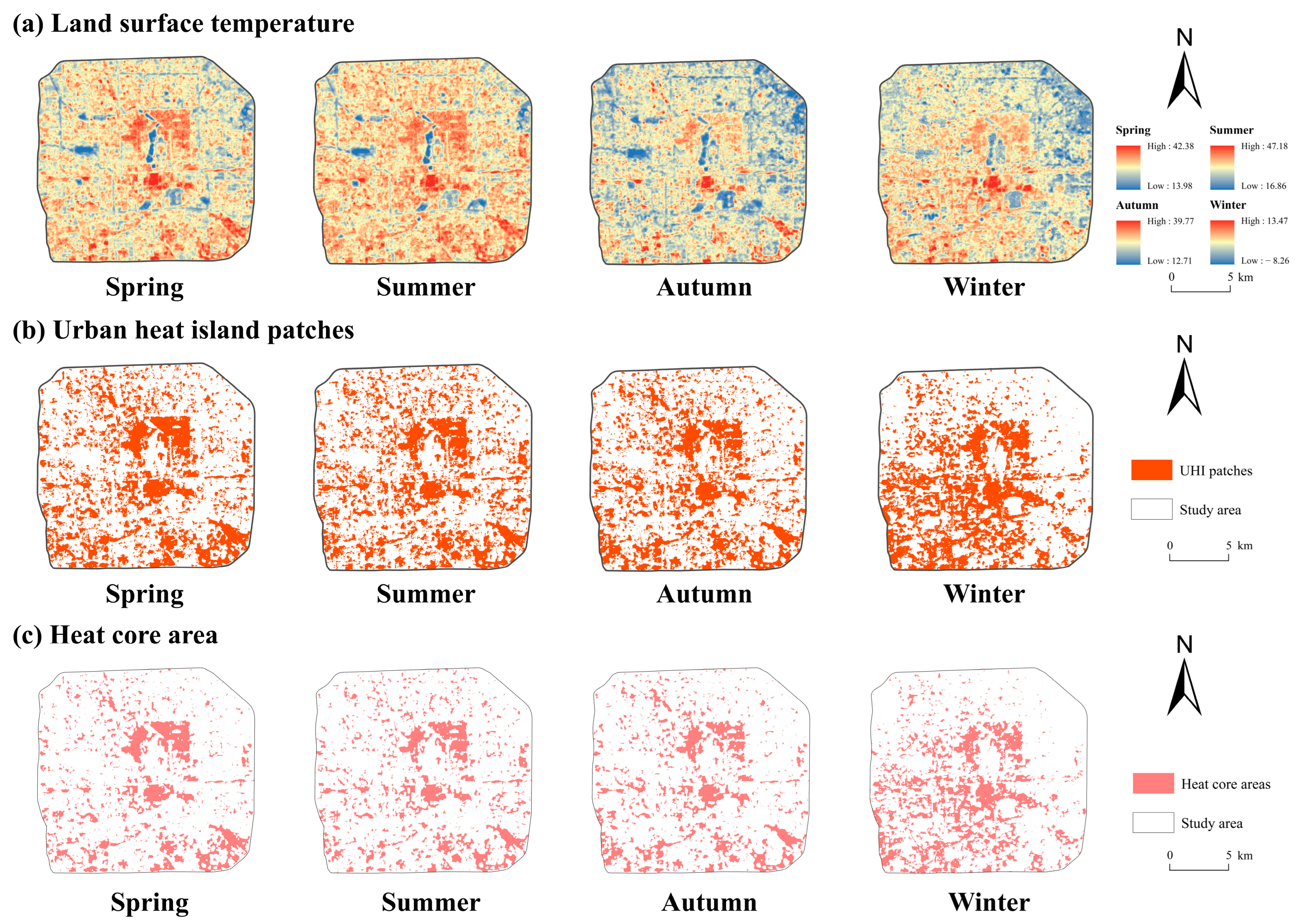
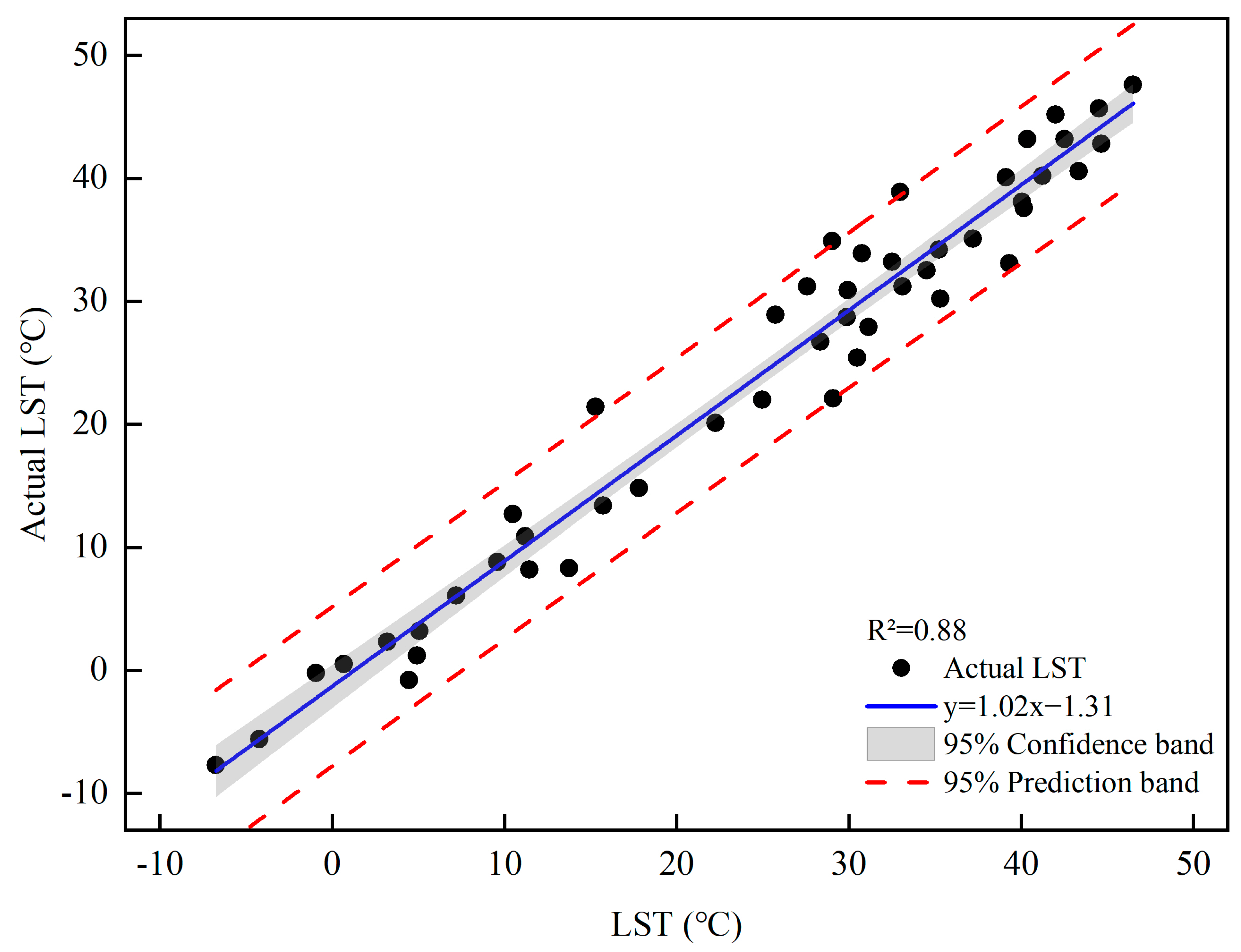
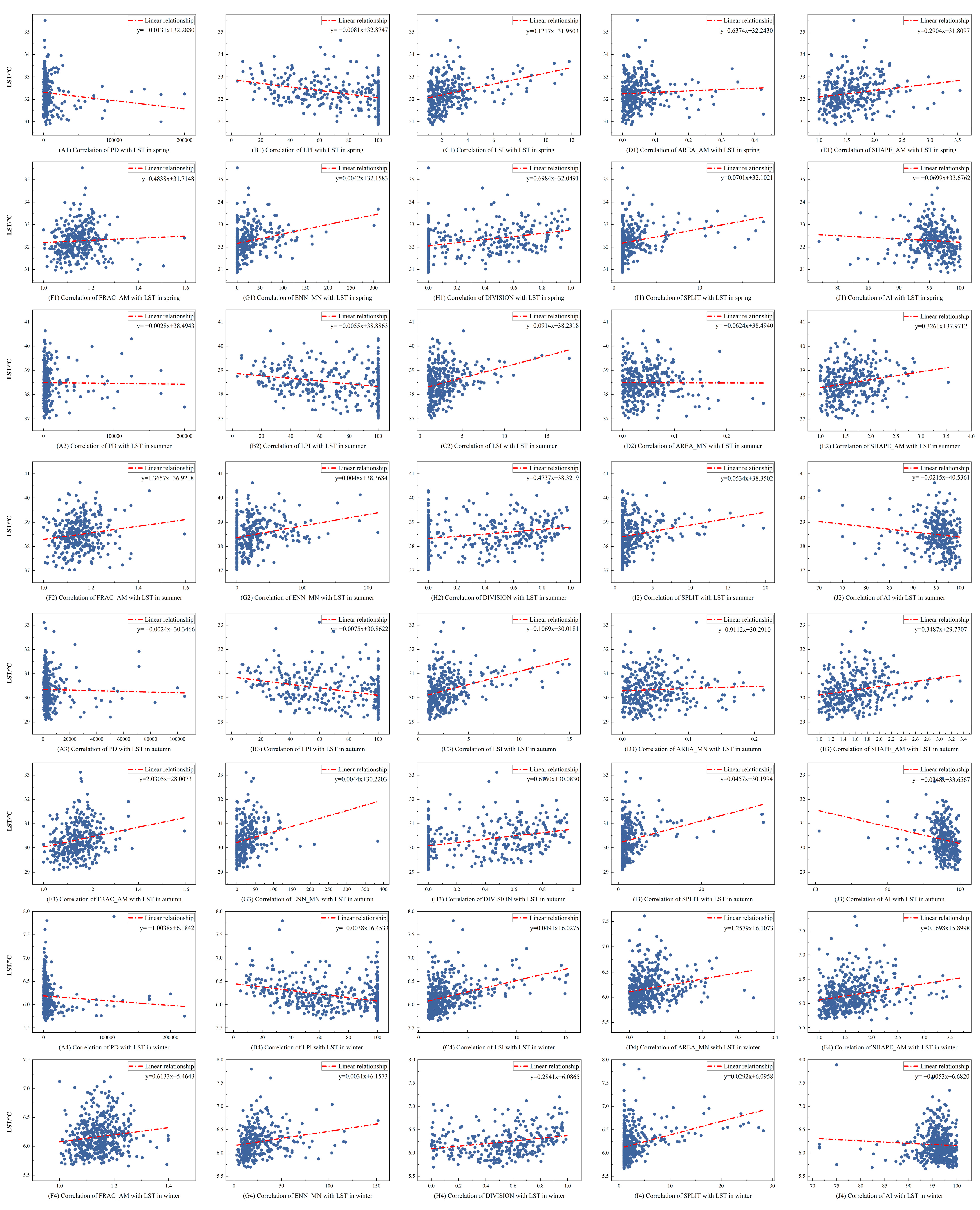

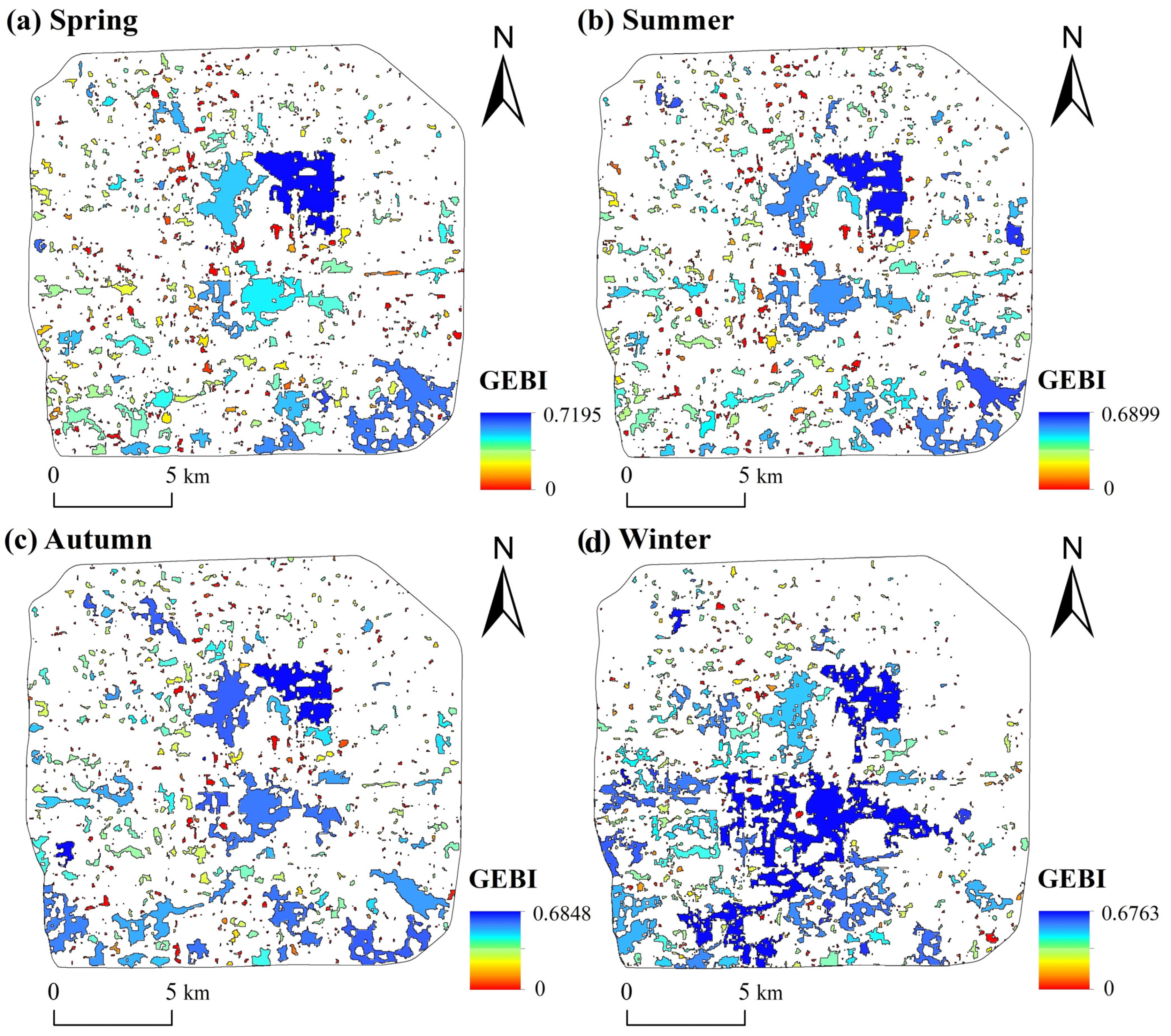
| Metrics | Abbreviation | Description | Formula | Unit |
|---|---|---|---|---|
| Patch density | represents the density of patches of UGS | Number per 100 hectares | ||
| Largest patch index | The largest patch of UGS patch | Percent | ||
| Landscape shape index | Landscape shape index of UGS patch | —— | ||
| Area-weighted mean patch size | Mean patch size of the corresponding patch type | —— | Hectare | |
| Area-weighted mean shape index | represents the area-weighted average shape index of UGS | —— | —— | |
| Area-weighted patch fractal | FRAC_AM reflects shape complexity | —— | —— | |
| Area-weighted Euclidean nearest neighbor distance | It is the ENN-MN weighted by the relative area of patches | Meter | ||
| Aggregation index | AI represents the degree of aggregation between landscape patches | Percent | ||
| Landscape division index | Landscape division index of UGS patch | —— | ||
| Splitting index | Splitting index of UGS patch | —— |
| Season | PD | LPI | LSI | AREA_MN | SHAPE_AM | FRAC_AM | ENN_MN | DIVISION | SPLIT | AI |
|---|---|---|---|---|---|---|---|---|---|---|
| Spring | 0.908 | 0.595 | 0.899 | 0.816 | 0.943 | 0.937 | 0.587 | 0.585 | 0.595 | 0.978 |
| Summer | 0.928 | 0.636 | 0.824 | 0.835 | 0.902 | 0.913 | 0.632 | 0.632 | 0.639 | 0.971 |
| Autumn | 0.951 | 0.779 | 0.939 | 0.859 | 0.939 | 0.938 | 0.770 | 0.768 | 0.779 | 0.967 |
| Winter | 0.894 | 0.688 | 0.842 | 0.819 | 0.859 | 0.853 | 0.666 | 0.679 | 0.686 | 0.924 |
| Season | Formula |
|---|---|
| Spring | 0.1315 × PD + 0.0329 × LPI + 0.1147 × LSI + 0.0818 × AREA_MN + 0.1821 × SHAPE_AM + 0.1588 × FRAC_AM+0.0270 × ENN_MN + 0.0236 × DIVISION + 0.0387 × SPLIT + 0.2089 × AI |
| Summer | 0.1751 × PD + 0.0378 × LPI + 0.0782 × LSI + 0.1074 × AREA_MN + 0.1455 × SHAPE_AM + 0.1266 × FRAC_AM+0.0279 × ENN_MN + 0.0321 × DIVISION + 0.0434 × SPLIT + 0.2259 × AI |
| Autumn | 0.1649 × PD + 0.0527 × LPI + 0.1433 × LSI + 0.0750 × AREA_MN + 0.1246 × SHAPE_AM + 0.1083 × FRAC_AM+0.0435 × ENN_MN + 0.0378 × DIVISION + 0.0527 × SPLIT + 0.1972 × AI |
| Winter | 0.1752 × PD + 0.0501 × LPI + 0.1200 × LSI + 0.0877 × AREA_MN + 0.1381 × SHAPE_AM + 0.1044 × FRAC_AM+0.0329 × ENN_MN + 0.0378 × DIVISION + 0.0435 × SPLIT + 0.2103 × AI |
Disclaimer/Publisher’s Note: The statements, opinions and data contained in all publications are solely those of the individual author(s) and contributor(s) and not of MDPI and/or the editor(s). MDPI and/or the editor(s) disclaim responsibility for any injury to people or property resulting from any ideas, methods, instructions or products referred to in the content. |
© 2023 by the authors. Licensee MDPI, Basel, Switzerland. This article is an open access article distributed under the terms and conditions of the Creative Commons Attribution (CC BY) license (https://creativecommons.org/licenses/by/4.0/).
Share and Cite
Liu, J.; Wu, J.; Yang, Y.; Zhang, B.; Yin, L. Evaluation of the Seasonal Thermal Environmental Benefits of Urban Green Space in the Core Areas of Urban Heat Island. Forests 2023, 14, 1500. https://doi.org/10.3390/f14071500
Liu J, Wu J, Yang Y, Zhang B, Yin L. Evaluation of the Seasonal Thermal Environmental Benefits of Urban Green Space in the Core Areas of Urban Heat Island. Forests. 2023; 14(7):1500. https://doi.org/10.3390/f14071500
Chicago/Turabian StyleLiu, Jiachen, Jianting Wu, Yong Yang, Baolei Zhang, and Le Yin. 2023. "Evaluation of the Seasonal Thermal Environmental Benefits of Urban Green Space in the Core Areas of Urban Heat Island" Forests 14, no. 7: 1500. https://doi.org/10.3390/f14071500
APA StyleLiu, J., Wu, J., Yang, Y., Zhang, B., & Yin, L. (2023). Evaluation of the Seasonal Thermal Environmental Benefits of Urban Green Space in the Core Areas of Urban Heat Island. Forests, 14(7), 1500. https://doi.org/10.3390/f14071500




